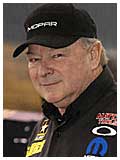
11/22/06 On Nov. 12, 2006, NHRA announced that Dan Olson was named as Director, Top Fuel and Funny Car Racing, replacing Ray Alley. Olson starts his new position on Dec. 1. Olson has been a manufacturer and racer for more than 40 years, most recently working as assistant crew chief, overlooking the operations of all teams at Don Schumacher According to NHRA, Olson will be responsible for “working directly with Top Fuel and Funny Car teams to enhance the quality of the show, make the sport safer for the fans and its competitors, and enforce NHRA rules and regulations.” DRO’s Darr Hawthorne had a conversation with Olson about where he thinks the sport is right now and where he thinks it should be headed. DRO: There’s a big change coming for you next year. Is this like putting you out to “pasture" from your previous duties with Schumacher Racing? Dan Olson: No, I think it’s going to be a new frontier. By no means. In fact I’m going to jump right into the frying pan probably, but not out to pasture, no. DRO: Is this something that you wanted to do? DO: Well, Ray (Alley) had talked to me before and I always kind of took it as a joke – yeah, when I get ready to retire it might be a good retirement job, but believe me this is not a good retirement job (laughing). It may be anything but a good retirement job. I think if we don’t do something relatively quick, I mean as soon as we can, for the racers andfor NHRA, due to the costs of the sport right now we are all going to be in trouble. I don’t care if it’s me or somebody else getting in there to make some changes and I think the sooner that happens the better we are all going to be. What’s going to be good for the racers will be good for the NHRA and what’s good for NHRA will be good for the racers. DRO: Does that mean slowing the nitro cars down? DO: No, I don’t think we need to slow the cars down. We’ve got to curtail the damage we are doing to the motors. Our motor life for every team out here is terrible. DRO: Is that a function of running nitro motors on 85%? DO: Yes, I think so. There are a lot of things that have gotten us to where we are now and that’s one of the things we need to look at. We can’t overcome the tire. Before we could overcome the tire anyplace on the track, but now we can’t do that. What we have done is reduced the percentage to reduce the power. Well, it didn’t take long for the racers to raise the power level as high or higher than it was before. The only problem is now is we’ve got so much compression and so much blower that these motors are on the verge of detonation all the time. So if we don’t have the fuel flow exactly right, the motor load exactly right, then we’ve got big-time motor damage.DRO: Is this damage primarily to the bottom end of the engine? DO: Yes, it’s mainly damage to the rods and crankshafts - real expensive parts. You see how much carnage there was this weekend, and this will continue. DRO: Does the mandated rev-limiter help or hurt this situation? DO: Well, we create the damage early (in the run) and then if the motor keeps running and it gets up on the rev-limiter, that just finishes it off. Does the rev-limiter work? Yeah, it works. It helps maintain 330 or 335 (miles per hour) and I think we can make the rev-limiter work better if we weren’t right on the verge of pre-ignition all the time, and that’s where we are on the verge of pre-ignition all the time. If you look at our motor parts today from back when we were running 90% I mean it is terrible. But again what we have done is we have our power level as high if not higher than we did on 90%. So what have we accomplished? The only thing we’ve accomplished really is accelerated the cost of running the car for the racer and then all the engine damage. You can see how often the tracks are oiled down. |
 Racing, since 1998. Under Olson's guidance in 1999, Tony Schumacher won the NHRA POWERade Top Fuel world championship. He also has served as crew chief for a number of other nitromethane teams including in the 1980s with Larry Minor's team, serving as crew chief for driver Cruz Pedregon, and before that, an assistant crew chief for driver Ed "Ace" McCulloch.
Racing, since 1998. Under Olson's guidance in 1999, Tony Schumacher won the NHRA POWERade Top Fuel world championship. He also has served as crew chief for a number of other nitromethane teams including in the 1980s with Larry Minor's team, serving as crew chief for driver Cruz Pedregon, and before that, an assistant crew chief for driver Ed "Ace" McCulloch.